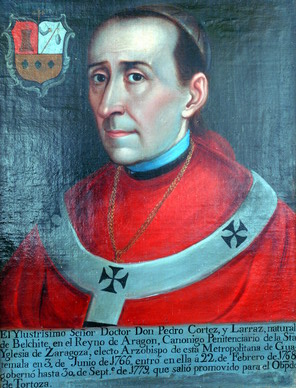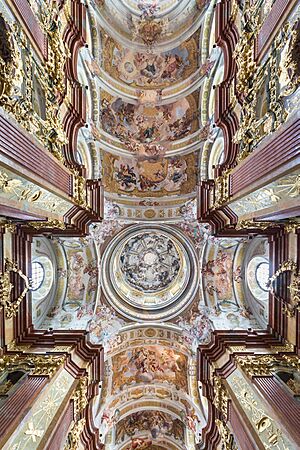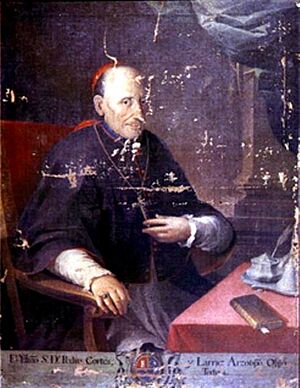Pedro Cortés y Larraz facts for kids
Quick facts for kids The Most Reverend Pedro Cortés y Larraz |
|
|---|---|
| Archbishop of Guatemala | |

Official portrait
|
|
| Province | Guatemala |
| Diocese | Santiago de los Caballeros de Guatemala |
| See | Guatemala City |
| Enthroned | 1767 |
| Reign ended | 1779 |
| Predecessor | Francisco José de Figueredo y Victoria |
| Successor | Cayetano Francos y Monroy |
| Other posts | Bishop of Tortosa (1780–1786) |
| Orders | |
| Consecration | 1767 |
| Personal details | |
| Born | 6 July 1712 Belchite, |
| Died | 7 July 1787 (aged 75) Zaragoza, |
| Nationality | Spanish |
| Denomination | Catholic |
Pedro Cortés y Larraz was an important leader in the Catholic Church. He was the Archbishop of Guatemala from 1767 to 1779. Later, he became the bishop of Tortosa in Spain. He was born in Belchite, Spain, on July 6, 1712, and passed away in Zaragoza, Spain, on July 7, 1787.
Contents
Life and Work
Early Years and Priesthood
Pedro Cortés y Larraz earned a special degree called a doctorate in Spain. He was twenty-nine years old at the time. After finishing his studies, he became a priest. He then moved to the Spanish lands in America. There, he was made a bishop by another church leader, Francisco Fabián Fuero, in Puebla de los Ángeles.
Archbishop of Guatemala
When Pedro Cortés y Larraz became the Archbishop of Guatemala, he wanted to learn about his new area. He planned a long trip to visit all parts of his archdiocese. An archdiocese is a large area managed by an archbishop. Before he started, he sent letters to all the local priests. He asked them to prepare reports for him.
His trip lasted almost two years, from November 1768 to August 1770. During this journey, he wrote a book. It was called Descripción Geográfico-Moral de la Diócesis de Goathemala. This book described the geography and moral life of the area.
By 1769, Cortés y Larraz was not happy with the church situation in his new area. He felt so disappointed that he offered to resign. However, King Carlos III did not accept his resignation. So, he had to continue his work as archbishop. He was a strong person who defended the church's teachings. This often led to disagreements with Spanish leaders and even other church members.
The Santa Marta Earthquake

In 1773, Captain General Martín de Mayorga took office. He, along with Archbishop Cortés y Larraz and other church leaders, were the main authorities in Guatemala. They would soon face a huge challenge.
In May 1773, small tremors began to shake the city. These tremors slowly grew stronger. On June 11, 1773, a bigger earthquake damaged many homes and buildings. Then, on July 29, 1773, a very powerful earthquake hit. This day was known as Santa Marta de Bethania.
This earthquake caused a lot of damage across the city. However, not everything was completely destroyed. Despite this, Captain General Martín de Mayorga asked the King of Spain for permission to move the city. This request was made on July 21, 1775.
The king agreed on January 2, 1776. The new location chosen is where Guatemala City is today. At that time, Captain General Matías de Gálvez y Gallardo was in charge. Archbishop Cortés y Larraz did not agree with moving the city. He knew it would mean less power and money for his archdiocese. Also, all the churches and convents would need to be rebuilt. He did not have enough money for such a big project.
A New Archbishop Arrives
On November 26, 1777, Cayetano Francos y Monroy was chosen as the new Archbishop of Guatemala. This was a tough job because Cortés y Larraz strongly opposed moving the capital.
At first, Francos y Monroy delayed his arrival. But on November 20, 1778, the Spanish crown pressured him to go. So, he sailed from Cádiz, Spain, in May 1779. He brought a large support group with him. This group was carefully chosen to help him take control of the local priests in Guatemala. Many of these priests were almost openly rebelling.
On October 7, 1779, Francos y Monroy officially entered the new Guatemala City. The city was still being built. A month before, Cortés y Larraz had written a public letter. He said that the new archbishop was not legitimate and threatened him with excommunication. Excommunication means being formally removed from the church.
However, Francos y Monroy took quick action. He named new priests for the town of Jocotenango. He also traveled to the damaged old city, Santiago de los Caballeros de Guatemala. There, he gathered the Santa Rosa nuns and brought them to the new city. He planned to move the saint statues in November 1779. He spent a lot of money to finish building the Carmel and Capuchin convents in the new capital.
Later Life and Death
Tired of disagreeing with his replacement, Cortés y Larraz left Guatemala. He went back to Spain in 1779. There, he was appointed as the bishop of Tortosa. He resigned from this role in 1786. He then retired to Zaragoza, Spain, where he passed away in 1787.
See also
 In Spanish: Pedro Cortés y Larraz para niños
In Spanish: Pedro Cortés y Larraz para niños


